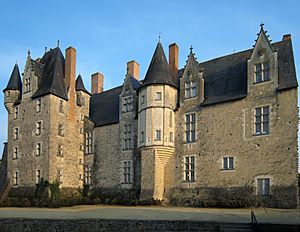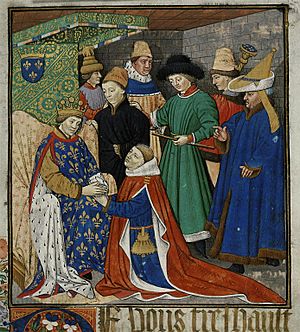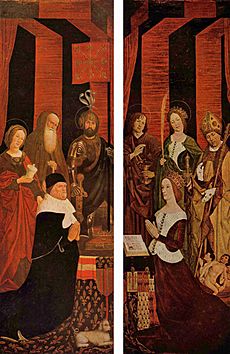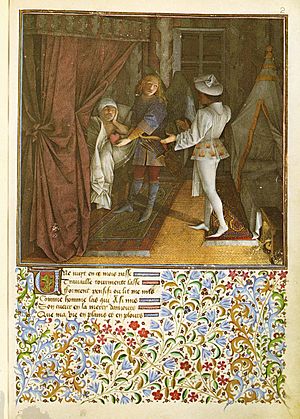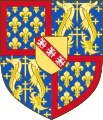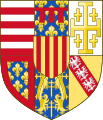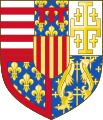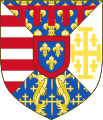René of Anjou facts for kids
Quick facts for kids René I |
|
|---|---|
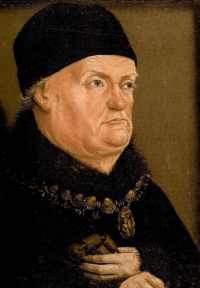
1474 portrait by Nicolas Froment
|
|
| King of Naples | |
| Reign | 2 February 1435 – 2 June 1442 |
| Predecessor | Joanna II |
| Successor | Alfonso I |
| Duke of Anjou Count of Provence |
|
| Reign | 12 November 1434 – 10 July 1480 |
| Predecessor | Louis III |
| Successor | Charles IV |
| Born | René of Anjou 16 January 1409 Château d'Angers, Angers, Anjou, France |
| Died | 10 July 1480 (aged 71) Aix-en-Provence, Provence, France |
| Burial | Angers Cathedral, Angers |
| Spouse |
Jeanne de Laval
(m. 1454) |
| Issue Detail |
|
| House | Valois-Anjou |
| Father | Louis II of Naples |
| Mother | Yolande of Aragon |
| Religion | Roman Catholicism |
| Signature |  |
René of Anjou (born January 16, 1409 – died July 10, 1480) was a powerful ruler in France during the 15th century. He was known as the Duke of Anjou and Count of Provence from 1434 until his death. He also held the title of King of Naples for a few years, from 1435 to 1442.
René was a member of the House of Valois-Anjou, a branch of the French royal family. He was the great-grandson of John II of France, a former king. For most of his life, he was also the brother-in-law of the French King Charles VII of France. People in France often called him the Good King René (Le bon roi René).
Contents
René's Early Life and Family
René was born on January 16, 1409, at the castle of Angers in France. His father was Louis II of Anjou, who was the Duke of Anjou and also claimed the title of King of Naples. His mother was Yolande of Aragon.
René was the second son in his family. His sister, Marie of Anjou, later married Charles VII of France, becoming the Queen of France.
When René's father died in 1417, René and his brothers were cared for by their mother. His older brother, Louis III, became the Duke of Anjou. René himself became the Count of Guise.
René's First Marriage
In 1419, when René was only ten years old, he was married to Isabella. She was the older daughter of Charles II, Duke of Lorraine. This marriage was important for connecting powerful families.
René was sent to live in Lorraine to be raised by Isabella's father and another important noble, Louis, Cardinal of Bar.
Becoming a Duke and King
When Louis of Bar died in 1430, René inherited the duchy of Bar. The next year, after his father-in-law Charles II died, René also became the Duke of Lorraine. However, another noble, Antoine de Vaudemont, challenged his claim to Lorraine.
Antoine, with help from the Burgundians, defeated René in battle in 1431. René was taken prisoner. He was released in 1432 after agreeing to give his two sons, John and Louis, as hostages.
Confirming His Titles
In 1434, the Holy Roman Emperor Sigismund confirmed René's title as Duke of Lorraine. This made the Duke of Burgundy, Philip the Good, angry. Philip forced René to return to prison in 1435. René was released two years later after a large payment was made.
In 1435, René's older brother Louis III died. René then inherited the Duchy of Anjou and the County of Maine. To make peace with the Burgundians, René's oldest son, John, married Marie of Bourbon, who was Philip of Burgundy's niece.
Claiming the Kingdom of Naples
Joanna II of Naples, the Queen of Naples, had chosen René's brother Louis III as her heir. After Louis's death, she offered the kingdom to René. In 1438, René sailed to Naples to claim his new kingdom.
However, Alfonso V of Aragon also claimed Naples. Alfonso had been chosen by Joanna II earlier, but she had changed her mind. In 1441, Alfonso attacked Naples. René returned to France that same year. Although he kept the title of King of Naples, he never truly ruled there again.
Later Life and Artistic Interests
René played a part in peace talks with the English in 1444. Peace was made stronger when his younger daughter, Margaret, married Henry VI of England.
René trusted King Charles VII of France. He helped the king with military plans against the English. René even entered the city of Rouen with Charles VII in 1449.
After his second marriage to Jeanne de Laval in 1454, René became less involved in politics. He spent more time on his hobbies, like writing poetry, painting, gardening, and raising animals. This is why he became known as the "Good King René."
Challenges and Decline
As René grew older, his family faced many difficulties. In 1466, people in Catalonia offered him the crown of Aragon. His son John went to conquer that kingdom but died in 1470, possibly from poison. John's oldest son, Nicholas, also died in 1473, again with suspicions of poisoning.
In 1471, René's daughter Margaret was defeated in the Wars of the Roses in England. Her husband and son were killed, and she was taken prisoner. King Louis XI later paid for her release in 1476.
René retired to Aix-en-Provence. He died there on July 10, 1480, and was buried in the Angers Cathedral.
René's Love for the Arts
René was known as a talented amateur painter. Many paintings from his time in Anjou and Provence were made under his guidance. These works often show the style of Early Netherlandish painting. He had a painter named Barthélémy d'Eyck working for him for many years.
Some famous artworks linked to René include the Burning Bush painting by Nicolas Froment in Aix Cathedral. This painting shows portraits of René and his second wife, Jeanne de Laval. René also owned two beautifully illustrated Book of Hours.
René encouraged plays, especially mystery plays which told religious stories. He even gave tax breaks to towns that put on these performances.
Writing and Books
René wrote two important allegorical works. An allegory is a story where characters and events represent deeper meanings.
- Le Mortifiement de vaine plaisance (The Mortification of Vain Pleasure, 1455) was about devotion.
- Le Livre du Cuer d'amours espris (The Book of the Love-Smitten Heart, 1457) was a love story.
Both books had beautiful illustrations, likely by his court painter, Barthélémy d'Eyck.
René also wrote King René's Tournament Book (Le Livre des tournois), around 1460. This book describes the rules for medieval tournaments. It is famous for its detailed watercolor drawings. The book focuses on the old customs of tournaments from France, Germany, and the Low Countries.
As a patron of the arts, René also paid for classical books to be translated into French.
Marriages and Issue
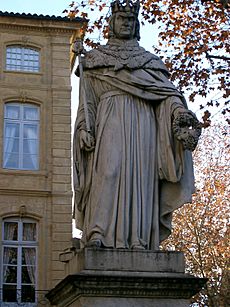
René was married twice:
- To Isabelle, Duchess of Lorraine (1400 – February 28, 1453) on October 24, 1420.
- To Jeanne de Laval on September 10, 1454.
His children with Isabelle were:
- John II (1424 – 1470), who became Duke of Lorraine and King of Naples.
- Louis (1427 – 1444), who was a hostage for his father.
- Nicholas (1428 – 1430).
- Yolande (1428 – 1483), who married Frederick of Lorraine.
- Margaret (1430 – 1482), who married King Henry VI of England.
- Charles (1431 – 1432).
- Isabelle (died young).
- René (died young).
- Louise (1436 – 1438).
- Anna (1437 – 1450).
René also had three children outside of marriage:
- John, Bastard of Anjou (died 1536).
- Jeanne Blanche (died 1470).
- Madeleine (died after 1515).
Images for kids
See also
 In Spanish: Renato I de Nápoles para niños
In Spanish: Renato I de Nápoles para niños
- Pas de la Bergère



